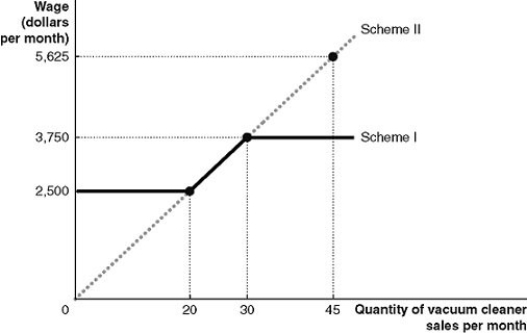Multiple Choice
Figure 17-6

Figure 17-6 shows two different compensation schemes for the Vortex Vacuum Cleaner Company.
Under Scheme I, the firm pays a consistent wage of $2,500 per month to all its salespeople for sales up to 20 vacuum cleaners. For sales of 21-30 vacuum cleaners, its salespeople earn $125 per vacuum cleaner, with wages capped at $3,750 per month for sales over 30 vacuum cleaners. If a salesperson has three consecutive months of sales below 20 vacuum cleaners, the person loses his or her job.
Scheme II represents a straight commission, with salespeople earning a commission of $125 per vacuum cleaner sold, with no wage cap.
-Refer to Figure 17-6.Under Scheme I,
A) workers compete with each other to see who can sell more than 20 vacuum cleaners in the shortest possible time.
B) workers have no incentive to sell more than 30 vacuum cleaners.
C) workers signal their productivity to the firm by consistently selling above 30 vacuum cleaners.
D) the incentive to increase productivity only occurs for sales of fewer than 20 vacuum cleaners or more than 30 vacuum cleaners.
Correct Answer:

Verified
Correct Answer:
Verified
Q13: What is the shape of the labor
Q14: In general, the supply curve for a
Q15: In many European countries, it is much
Q16: In the medical profession, pediatricians receive lower
Q17: Suppose a competitive firm is paying a
Q19: The total value to society of having
Q20: The marginal revenue product of labor is
Q21: The wage rate is the opportunity cost
Q22: Which of the following best explains why
Q23: One implication of compensating differentials is that